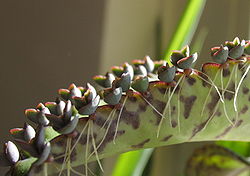Brood bodies


Brood bodies and brood buds (bulbils) are multicellular to multicellular organs in plants that are used for vegetative , asexual reproduction . A general term for organs of vegetative reproduction is breeding organ .
Brood bodies: Gems of the mosses
In mosses , cellular divisions can be found on the thallus , rhizoids , stems or leaflets, which under suitable circumstances can develop into new plants in the asexual way. In the deciduous mosses of the Tetraphidaceae family , these arise in special brood bud containers. With fountain liver moss , they are formed in their own breeding cups. In the case of mosses, these formations are usually referred to as brood bodies or gems.
Gemmen is also the name for certain permanent cells in fungi , such as arthrospores and chlamydospores .
Brood buds
Brood buds (bulbils) are specially shaped buds on above-ground organs of vascular plants (fern and seed plants). The leaves are often fleshy. They detach themselves when they are ripe and take root. They are formed on leaf axils, on leaves or in the inflorescence. In the Wurzelbulbillen the sproßbürtige root occupies most part of the Gemma, as in the buds of the nodules Scharbock herb ( Ranunculus ficaria ). This very seldom seed-bearing plant reproduces heavily from these brood buds. Axial bulbs like the nodule knotweed ( Polygonum viviparum ) contain a thickened stem axis on which small roots develop. The brood buds of the fire lily ( Lilium bulbiferum ) and the onion tooth root ( Cardamine bulbífera ) arise in the upper leaf axils and are enclosed by leaves in the form of onion skins.
The spread of plants via vegetative breeding shoots is known as blastochoria . Brood buds are also used specifically for the vegetative propagation of plants.
Individual evidence
- ↑ a b Gerhard Wagenitz : Dictionary of Botany. The terms in their historical context. 2nd, expanded edition. Spektrum Akademischer Verlag, Heidelberg / Berlin 2003, ISBN 3-8274-1398-2 , p. 52.
- ↑ a b Gerhard Wagenitz: Dictionary of Botany. The terms in their historical context. 2nd, expanded edition. Spektrum Akademischer Verlag, Heidelberg / Berlin 2003, ISBN 3-8274-1398-2 , p. 123.
